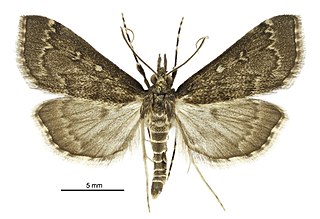
Proternia is a monotypic moth genus of the family Crambidae described by Edward Meyrick in 1884. Its only species, Proternia philocapna, described by the same author in the same year, is endemic to New Zealand.
Hexadactilia civilis is a moth of the family Pterophoridae. It is found in Queensland, Australia.
Batrachedra helarcha is a species of moth of the family Batrachedridae. It is found in Australia.
Batrachedra sterilis is a species of moth of the family Batrachedridae. It is found in Australia.
Dichomeris chalcophaea is a moth in the family Gelechiidae. It was described by Edward Meyrick in 1921. It is found in Australia, where it has been recorded from Queensland.
Hypatima tenebrosa is a moth in the family Gelechiidae. It was described by Edward Meyrick in 1920. It is found in Australia, where it has been recorded from South Australia.
Ardozyga cephalota is a species of moth in the family Gelechiidae. It was described by Edward Meyrick in 1904. It is found in Australia, where it has been recorded from Western Australia.
Ardozyga frugalis is a species of moth in the family Gelechiidae. It was described by Edward Meyrick in 1904. It is found in Australia, where it has been recorded from New South Wales and Western Australia.

Ardozyga nyctias is a species of moth in the family Gelechiidae. It was described by Edward Meyrick in 1904. It is found in Australia, where it has been recorded from southern Queensland and New South Wales.
Ardozyga temenitis is a species of moth in the family Gelechiidae. It was described by Edward Meyrick in 1904. It is found in Australia, where it has been recorded from Queensland.
Battaristis ardiophora is a moth of the family Gelechiidae. It was described by Edward Meyrick in 1914. It is found in Guyana, Brazil and Peru.
Pexicopia epactaea is a moth of the family Gelechiidae. It was described by Edward Meyrick in 1904. It is found in Australia, where it has been recorded from South Australia.
Pexicopia trimetropis is a moth of the family Gelechiidae. It was described by Edward Meyrick in 1922. It is found in Australia, where it has been recorded from Western Australia.

Thiotricha thorybodes is a species of moth in the family Gelechiidae. It was described by Edward Meyrick in 1885. It is endemic to New Zealand.
Sarisophora cyclonitis is a moth in the family Lecithoceridae. It was described by Edward Meyrick in 1904. It is found in Australia, where it has been recorded from Queensland.
Protolychnis trigonias is a moth in the family Lecithoceridae. It was described by Edward Meyrick in 1904. It is found in Australia, where it has been recorded from Queensland.
Imma synconista is a moth in the family Immidae. It was described by Edward Meyrick in 1918. It is found in Kanara, India.

Crypsitricha pharotoma is a species of moth in the family Tineidae. It was described by Edward Meyrick in 1888. This species is endemic to New Zealand.

Sporophyla oenospora is a species of moth in the family Pyralidae. It is endemic to New Zealand. It is classified as critically endangered by the Department of Conservation.

Tingena aletis is a species of moth in the family Oecophoridae. It is endemic to New Zealand and has been collected in the vicinity of Arthur's Pass in the South Island. Adults are on the wing in January.





